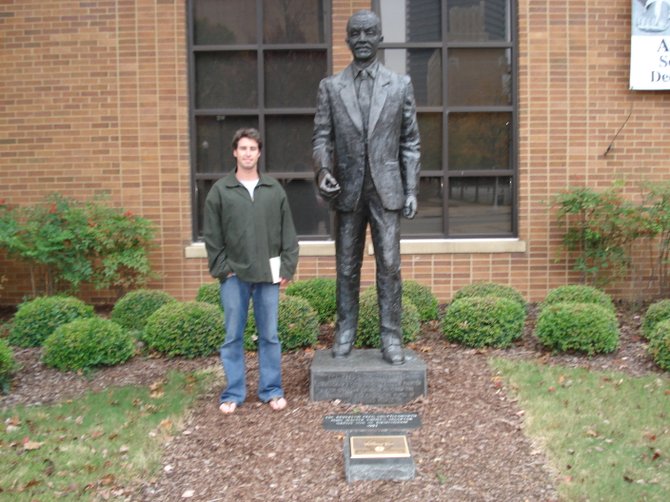 Facebook
Facebook
 X
X
 Instagram
Instagram
 TikTok
TikTok
 Youtube
Youtube

I was in my second grade history class, here in Southern California, when I first remember seeing the video images of men and women shotgun-hosed ruthlessly, police dogs trained to bite the nearest dark-skinned person, and nine bold Little Rock students walking into a vicious white crowd. But to me, this part of American history remained just a piece of our past that seemed so far away.
Enter Birmingham, Alabama, and a few hours to wander around. The Birmingham Civil Rights Institute beckoned for a visit.
The institute (open Tuesday-Saturday 10 a.m. to 5 p.m.; Sundays 1 p.m. to 5 p.m.) looked fairly unassuming in the opening greeting room. We were a group of about ten people formed solely by our arrival time. Will, an employee, took delicate care in describing the self-guided tour. He would later tell me that he recently moved from Chicago, because he felt the need to be part of this institute. It felt like the tour had already been knocked up a few points in powerfulness before it began in earnest.
We first sat down for a short film portraying the history of this “Magic City” – a nickname given for its booming steel industry in the early 1900s. But this nickname later changed to “Bombingham” in the 1950s and 1960s due to the city’s cacophony of racially motivated bombings. Birmingham had become a national and international center of the civil rights struggle.
The institute displays photographs and videos pulsating the brutality of the era as well as traveling and permanent exhibitions (such as a statue of Rosa Parks sitting in her bus seat on that famous December 1, 1955, ride) and in-depth information concerning activist leaders.
One of the civil rights leaders showcased is Mr. Fred Shuttlesworth, a local Birmingham pastor. This man vowed to “…kill segregation or be killed by it.” He spoke bluntly with a confrontational personality, at times antagonizing even his own colleagues. Martin Luther King, Jr. described Shuttlesworth as “…the most courageous civil rights fighter in the South.” Shuttlesworth is known for extreme situations like when he had just escaped his burning house, blown up by dynamite. The police officer waiting outside of the flaming house told Shuttlesworth to leave town. The reply: “I wasn’t saved to run.”
Seeing, hearing, and relearning this part of our history jolted me as I walked through the halls. And even though Shuttlesworth might be somewhat irked with me – as he apparently warned Dr. King against delivering “flowery speeches” and not taking an active enough role in the fight against segregation – the biggest chill came at the end of the tour to the sounds and visions of “I have a dream….”
If you find yourself in Birmingham, do yourself a favor and spend an afternoon with this history, its leaders, and the passion that changed our country forever.


I was in my second grade history class, here in Southern California, when I first remember seeing the video images of men and women shotgun-hosed ruthlessly, police dogs trained to bite the nearest dark-skinned person, and nine bold Little Rock students walking into a vicious white crowd. But to me, this part of American history remained just a piece of our past that seemed so far away.
Enter Birmingham, Alabama, and a few hours to wander around. The Birmingham Civil Rights Institute beckoned for a visit.
The institute (open Tuesday-Saturday 10 a.m. to 5 p.m.; Sundays 1 p.m. to 5 p.m.) looked fairly unassuming in the opening greeting room. We were a group of about ten people formed solely by our arrival time. Will, an employee, took delicate care in describing the self-guided tour. He would later tell me that he recently moved from Chicago, because he felt the need to be part of this institute. It felt like the tour had already been knocked up a few points in powerfulness before it began in earnest.
We first sat down for a short film portraying the history of this “Magic City” – a nickname given for its booming steel industry in the early 1900s. But this nickname later changed to “Bombingham” in the 1950s and 1960s due to the city’s cacophony of racially motivated bombings. Birmingham had become a national and international center of the civil rights struggle.
The institute displays photographs and videos pulsating the brutality of the era as well as traveling and permanent exhibitions (such as a statue of Rosa Parks sitting in her bus seat on that famous December 1, 1955, ride) and in-depth information concerning activist leaders.
One of the civil rights leaders showcased is Mr. Fred Shuttlesworth, a local Birmingham pastor. This man vowed to “…kill segregation or be killed by it.” He spoke bluntly with a confrontational personality, at times antagonizing even his own colleagues. Martin Luther King, Jr. described Shuttlesworth as “…the most courageous civil rights fighter in the South.” Shuttlesworth is known for extreme situations like when he had just escaped his burning house, blown up by dynamite. The police officer waiting outside of the flaming house told Shuttlesworth to leave town. The reply: “I wasn’t saved to run.”
Seeing, hearing, and relearning this part of our history jolted me as I walked through the halls. And even though Shuttlesworth might be somewhat irked with me – as he apparently warned Dr. King against delivering “flowery speeches” and not taking an active enough role in the fight against segregation – the biggest chill came at the end of the tour to the sounds and visions of “I have a dream….”
If you find yourself in Birmingham, do yourself a favor and spend an afternoon with this history, its leaders, and the passion that changed our country forever.
Comments